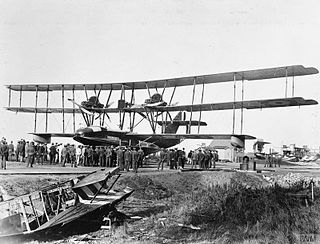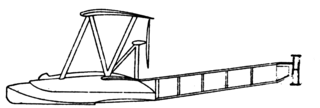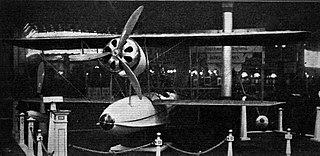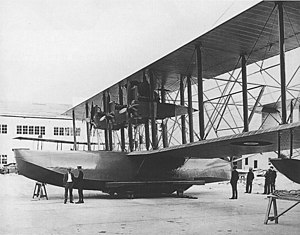
The NC-4 was a Curtiss NC flying boat that was the first aircraft to fly across the Atlantic Ocean, albeit not non-stop. The NC designation was derived from the collaborative efforts of the Navy (N) and Curtiss (C). The NC series flying boats were designed to meet wartime needs, and after the end of World War I they were sent overseas to validate the design concept.

The McDonnell XP-67 "Bat" or "Moonbat" was a prototype for a twin-engine, long-range, single-seat interceptor aircraft for the United States Army Air Forces. Although the design was conceptually advanced, it was beset by numerous problems and never approached its anticipated level of performance. The project was cancelled after the sole completed prototype was destroyed by an engine fire.

The Short S.14 Sarafand was a British biplane flying boat built by Short Brothers. It was planned as a general reconnaissance aircraft for military service. When it was built in 1932 it was the largest aeroplane in the United Kingdom.

The Naval Aircraft Factory PN was a series of open cockpit American flying boats of the 1920s and 1930s. A development of the Felixstowe F5L flying boat of the First World War, variants of the PN were built for the United States Navy by Douglas, Keystone Aircraft and Martin.
The Naval Aircraft Factory TF was a United States twin-engine flying-boat escort fighter first flown in October 1920. The aircraft originated from requirements drafted by the British Technical Committee in April 1918, after discussion approved the development of a long-range seaborne fighter capable of escorting Allied maritime reconnaissance sorties over the North Sea and Atlantic regions.

The Curtiss HS was a single-engined patrol flying boat built for the United States Navy during World War I. Large numbers were built from 1917 to 1919, with the type being used to carry out anti-submarine patrols from bases in France from June 1918. It remained in use with the US Navy until 1928, and was also widely used as a civil passenger and utility aircraft.

The Curtiss Model R was a utility aircraft produced for the United States Army and Navy during World War I. It was a conventional, two-bay biplane with slightly staggered wings of unequal span. The aircraft was provided with two open cockpits in tandem and fixed tailskid undercarriage, but many were built for the Navy with twin floats replacing the wheels. During the course of the war, Model Rs were used for general liaison and communication duties, as well for observation, training, and as air ambulances. In practice, the Curtiss powerplants supplied with these aircraft proved insufficient and were mostly replaced with Liberty engines. The Navy's Model R-3 floatplane had extended-span, three-bay wings, and was intended for use as a torpedo bomber. Some of these were later fitted with wheeled undercarriage and transferred to the Army as bombers under the designation Model R-9.

The Felixstowe F.4 Fury, also known as the Porte Super-Baby, was a large British, five-engined triplane flying-boat designed by John Cyril Porte at the Seaplane Experimental Station, Felixstowe, inspired by the Wanamaker Triplane/Curtiss Model T. At the time the Fury was the largest seaplane in the world, the largest British aircraft, and the first aircraft controlled successfully by servo-assisted means.
The Farman F.51 was a 1920s French maritime reconnaissance flying boat designed and built by Farman. The F.51 was an unequal-span four-bay biplane flying boat with a crew of four. It was powered by two Lorraine 8bd engines mounted in tractor configuration. A pusher engined version was designated the Farman F.50 . Tested by the French Navy but it failed to win any orders, Farman did briefly consider a civil version but the project was abandoned.

The General Aviation PJ was a flying boat produced in the United States in the 1930s as a search-and-rescue aircraft for the Coast Guard. Originally designated FLB, it was a conventional high-wing cantilever monoplane with a flying boat hull and outrigger pontoons mounted on the wings slightly outboard of mid-span. The twin pusher engines were carried in separate nacelles on pylons above the wings. The hull was a monocoque metal structure, and the wing was a wooden structure skinned with plywood. The basic design was based on that of the Fokker F.11, but substantially enlarged. While not a true amphibian and able to land on dry land, the PJ was equipped with retractable undercarriage that functioned as its own, self-carrying beaching trolley.
The Grahame-White Ganymede was a prototype British heavy night bomber intended to serve with the Royal Air Force in the First World War. A large, three-engined, twin-boom biplane, the sole prototype Ganymede did not fly until after the war had ended, and although an attempt was made to convert the aircraft to an airliner, it was unsuccessful.

The Hall XP2H-1 was an American prototype four-engined biplane flying boat of the 1930s. Intended as an experimental very-long-range maritime patrol aircraft, a single example was built. The XP2H-1 was the largest four engine biplane aircraft ever procured by the US Navy.

The Curtiss C-1 Canada was a twin-engined bomber aircraft of the First World War which was designed by Curtiss of America to be built by their Canadian subsidiary for the British Royal Naval Air Service and Royal Flying Corps. Although large orders were placed, only twelve were built, the type being rejected in favour of more capable aircraft such as the Handley Page O/100.

The Wanamaker Triplane or Curtiss Model T, retroactively renamed Curtiss Model 3 was a large experimental four-engined triplane patrol flying boat of World War I. It was the first four-engined aircraft built in the United States. Only a single example (No.3073) was completed. At the time, the Triplane was the largest seaplane in the world.

The Zeppelin-Lindau Rs.II was a biplane flying boat, designed by Claudius Dornier and built during 1914-15 on the German side of Lake Constance. Initially this aircraft was powered by three engines mounted inside the hull driving three pusher propellers via gearboxes and shafts. The later version was powered by four engines in two push-pull nacelles mounted between the wings.

The Curtiss CA-1 was an American five-seat biplane amphibian designed by Frank Courtney and built by Curtiss-Wright at St Louis, Missouri.

The Pemberton-Billing P.B.1, sometimes known as the Supermarine, was a 1910s British single-seat flying-boat built by Pemberton-Billing Limited, which later became the Supermarine Aviation Works. Only one P.B.1 was built, and it never flew any distance further than a hop.

The Hanriot H.110 was an unusual pusher configuration, twin boom, single seat fighter aircraft built in France in the early 1930s. It proved to be slower and less manoeuvrable than its contemporaries and failed to reach production, even as the Hanriot H.115 after receiving a more powerful engine and cannon armament.
The Astra 1916 bomber was a large 3-engined biplane, with two fuselages and a central nacelle. Power was supplied by three 220 hp (160 kW) Renault 12Eb water-cooled V-12 piston engines, two tractor engines in the noses of the fuselages and a pusher engine at the rear of the central nacelle. The flight crew of two sat in individual cockpits in the central nacelle and a gunner were housed in a cockpit, aft of the wings, in each fuselage. Designed for a 1916 concours puissant the performance of the aircraft was unsatisfactory and further development was abandoned.
The Naval Aircraft Factory Giant Boat or GB was a 1919 maritime patrol aircraft project undertaken by the Naval Aircraft Factory (NAF), the in-house aircraft production arm of the United States Navy. The proposed flying boat was larger and heavier and would have possessed a longer range than any similar type then in existence, but the project was hampered by labor and funding shortages stemming from deep post-World War I U.S. military budget cuts, and in 1921, navy leaders prioritized other aircraft types and ended the project. The single incomplete prototype is believed to have been broken up after 1925.


















